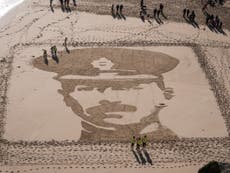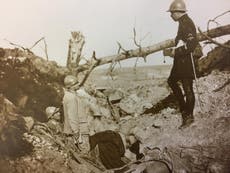1917 dares to show the consequences of violence – we mustn’t look away
It’s crucial that young people are taught what war actually does to people. The latest First World War film shouldn’t have been given a 15 certificate

Having seen the trailers and some of the promo material, I was disappointed, but perhaps not surprised, that Sam Mendes’ First World War epic 1917 received a 15 certificate.
The disappointment came because my son, who’s at secondary school, is keen on history, and while movies like this inevitably serve up a fictionalised version of it, they’re a good jumping-off point for a discussion when we can go and see them together.
This one in particular, set in the First World War, is very timely given the events in the Middle East and the bellicose drumbeat accompanying them.
That gut-wrenching conflict is less readily fetishised by nationalists who’ve never fought for anything beyond their own self-aggrandisement, because the overwhelming takeaways from it are sadness and regret.
1917 is one of those pictures that seeks to show that as much as a movie can, and to give a taste of what conflict really entails. So blood, rats, dirt, death and tears.
Even if the attempt at realism is undermined a bit later on in the picture – to avoid a spoiler I’ll simply say “hypothermia?” and you’ll get the point if you see it – the movie does seek to show the consequences of violence alongside the violence itself.
Which leads us to the 15.
When I contacted the British Board of Film Classification (BBFC) to ask about the certification, I was told that its research showed that viewers are “less concerned by violence in historical settings than by violence in more contemporary settings, particularly if there is educational merit and if the violence is depicted in a manner that seeks to emphasise the consequences of violence”.
But, said its head of compliance, 1917 was given its rating because of its strong images of injury detail in the aftermath of violence. The sight of decaying corpses and severed limbs, for example.
And also the double-figure incidence of bad language, even though the swearing isn’t gratuitous – and really, what’s the difference between one F-bomb and 10? You hear the word just the same.
I am, however, more interested in the consequences of conflict, and what our attitude to what’s acceptable says about us.
The BBFC, which takes its lead from the public, told me that were it just down to the violence, 1917 would have been given a 12A, which is what the recent but rather lower-quality war flick Midway received despite a fairly graphic depiction of a burn victim and some bodies.
But parents, said the board, “do not expect to see the graphic sight of blood and injury in films rated 12A”.
Wait a minute. Doesn’t that mean we’re guilty of trying to sugar-coat violence, to airbrush away its consequences?
By refusing to show the all too real effects of it until kids get to 15, aren’t we guilty of sending out the wrong message?
Films, TV shows, they show people getting shot, punched, stabbed, even strangled all the time. The actors either expire with a theatrical “urrgghhh” or get up after a slightly less dramatic “urrgghhh” and maybe limp along on a bloodless leg or hold onto another bloodless body part to show it’s been injured.
There is an economic incentive for the makers of films and TV programmes to indulge in such soft-soaping in pursuit of the widest possible audience. But maybe that has an impact on both children and adults alike. Maybe airbrushing the consequences of violence dulls the senses.
Perhaps if we were all more often exposed to those consequences, we’d be less keen to indulge. Perhaps we’d also be less willing to endorse politicians who’ve been known to shake their fists at violent TV shows or video games on the one hand while contemplating throwing young people’s lives away on wars in other people’s countries on the other.
I’m not arguing that children, young children in particular, should be freely exposed to blood and guts on screen, even though some very young children are at this very moment being brutally exposed to them in real life at an age when the most challenging thing they encounter should be Toy Story 4.
Nor am I calling for Spider-Man with gore. I understand the need for escapism – goodness knows I need it myself. And I certainly wouldn’t take my eight-year-old to 1917.
But I think older children should be allowed to see films that explore the realities of violence’s aftermath if they aren’t of the sensitive type.
There is, perhaps, a solution. You could make a case for a rarely used “hard” 12, restricted to those above that age, as opposed to a 12A that much younger children can see as long as they have an adult in tow.
That might give kids in secondary education the chance to better understand the real impact that the conflicts they are learning about, seeing reported on TV news programmes and hearing those drums beating in favour of will have on real people.






Join our commenting forum
Join thought-provoking conversations, follow other Independent readers and see their replies